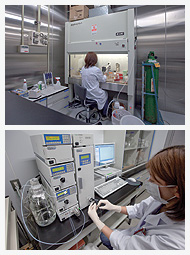Research Laboratory of Material Cycles and Waste Management
[1F] Thermal treatment plant
This room is for the assessment of material behaviors (gasification, volatilization, decomposition, chemical reaction, condensation, removal, etc.) in the process of thermal treatment (incineration) of waste. It is equipped with a kiln type main combustor which can observe the combustion process and secondary combustion chambers with variable residence time, as well as various devices for fl ue gas treatment, such as removal of acid gas using slaked lime or other chemicals, dust removal using fabric filter, and absorption and removal of hazardous substances using activated carbon layer. We are conducting combustion experiments using different kinds of waste under conditions (e.g. oxidation and reduction) to clarify chemical substances behaviors in thermal and fl ue gas treatment processes.

[1F] Landfill simulation plants

This laboratory is used for clarifying the behavior of various substances in landfill conditions, assessing safety and stabilization, and developing technologies and systems for landfills. It is equipped with landfill simulation lysimeters, which have an on-line monitoring and automatic control system for temperature, moisture, and aerobic/anaerobic conditions to maintain environmental conditions close to those in actual landfills. In addition, there are high-precision scales just under the landfill columns for monitoring the changes in weight, thus permitting the precise calculation of mass balance. We are trying to clarify scientifically the changes and behaviors, such as leaching, that landfill and micro-pollutants contained therein show over a long time by using these simulation plants.
[1F] Experimental equipment for pyrolysis gasification/reformation

This equipment is used for process development to effectively recover energy from combustible waste and to generate hydrogen and carbon monoxide which can be used as raw material.
The equipment processes relatively dry woody biomass with a certain level of caloric value and combustible waste such as paper and plastics.
These materials are partially combusted with a small amount of air and reacted with high temperature steam and carbon dioxide to generate hydrogen and carbon monoxide.
As well, through the use of reforming catalysts and catalyst support materials, steam reforming is performed promptly as decomposition of high-boiling hydrocarbon compounds called tar is accelerated.
Moreover, generation behavior of corrosive/ toxic gases which originate from sulfur, chloride, etc. contained in waste and a method to purify them are being investigated.
[1F] Sample preparation room for plant experiments
This room is designated for the preparation of samples by crushing and drying as a pretreatment for analysis of various types of solid waste and recycling materials. It is equipped with powerful and versatile crushers which can cover from hard (e.g. melting slag) to soft materials (e.g. waste plastics), and prepare samples having various particle sizes from rough to fine. Prepared samples are used for various purposes such as a leachability test of hazardous substances and the investigation of pyrolysis characteristics. Installed in a space completed with a vent duct for leak prevention and collection of odor are three large-sized dryers, which have sufficient capacity to dry a large amount of wet waste in a short time. They are used for pre-treating samples for garbage composition analysis, three-component analysis (combustibles, ashes, water), heat value analysis and elemental composition analysis performed in a dried state.
[2F] Chemical analysis laboratory for resources

This laboratory is used for assessing recyclable resources in terms of the characterization and environmental impact of waste by instrumental analysis. It is equipped with instruments for analyzing organic compounds, including gas chromatograph-mass spectrometers, highperformance liquid chromatographs and a Fourier transform infrared spectrometer. In addition, there is a scanning electron microscope with energy dispersion X-ray analyzer to determine the elemental composition of the surface. Using these instruments, we evaluate the quality of recyclable resources such as melting slag through the observation of the surfaces and conduct research on the proper disposal of asbestos-containing waste by observing and counting asbestos fibers in the waste and their thermally treated residues.
[2F] Biological analysis laboratory

Continual comprehensive monitoring of various hazardous substances that may be included in waste or produced during waste-recycling and treatment is difficult with conventional chemical analysis only. The bioassay (or biotest), which uses cultured cells, microbes, fish or other organisms, is designed to obtain quick and comprehensive information on the harmful effects of chemical substances on living organisms, and so has been used as complementary method for whole hazard monitoring and assessment. This laboratory is equipped with constant-temperature aquariums for breeding and keeping aquatic organisms for tests, an isolated clean room for safely testing microbes, and micro-plate readers for detecting absorption, fl uorescence and bioluminescence for simultaneously treating many samples. Using these instruments, we are developing reasonable sets of bioassay methods (i.e. "batteries") employing a range of living organisms from microorganisms to higher animals such as frogs and fish for the examination of waste and recycling resources. The batteries are also useful for monitoring the effects of chemicals in emissions from waste treatment, recycling and disposal facilities.
[2F] GC/MS room

This room was designed for determining trace amounts of organic components included in waste and related samples, mainly using the high-resolution gas chromatograph-mass spectrometer (GC/MS). A sample preparation room is also attached, where extraction and cleaning up of samples are conducted for precise measurement. Both rooms were designed to maintain the same conditions as a clean room to prevent contamination from a polluted atmosphere. We are developing reliable methods to determine trace amounts of PCBs (polychlorinated biphenyls), halogenated organic compounds such as brominated fl ame retardants and persistent organic pollutants in waste and related samples. We are also developing technologies for destroying these chemicals.



